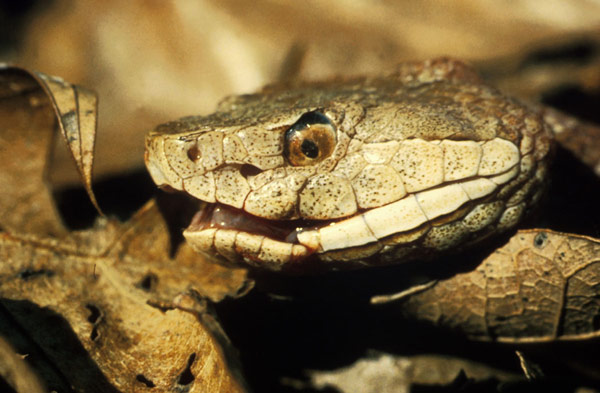
An evolutionary arms race between early snakes and mammals triggered the development of improved vision and large brains in primates, a radical new theory suggests.
The idea, proposed by Lynne Isbell, an anthropologist at the University of California, Davis, suggests that snakes and primates share a long and intimate history, one that forced both groups to evolve new strategies as each attempted to gain the upper hand.
To avoid becoming snake food, early mammals had to develop ways to detect and avoid the reptiles before they could strike. Some animals evolved better snake sniffers, while others developed immunities to serpent venom when it evolved. Early primates developed a better eye for color, detail and movement and the ability to see in three dimensions—traits that are important for detecting threats at close range.
Humans are descended from those same primates.
Gallery: Snakes of the World Snake News Deadly Aim: Cobras Really Do Shoot for the Eyes Millions of Years Ago, Snakes Were Hip Flying Snakes: New Videos Reveal How They Do It Race Fears Linger Like Dread of Snakes The Surprising Origin of Venom Revealed Snakes in Trouble
Scientists had previously thought that these traits evolved together as primates used their hands and eyes to grab insects, or pick fruit or to swing through trees, but recent discoveries from neuroscience are casting doubt on these theories.
"Primates went a particular route," Isbell told LiveScience. "They focused on improving their vision to keep away from [snakes]. Other mammals couldn't do that. Primates had the pre-adaptations to go that way."
Harry Greene, an evolutionary biologist and snake expert at Cornell University in New York, says Isbell's new idea is very exciting.
Get the world’s most fascinating discoveries delivered straight to your inbox.
"It strikes me as a very special piece of scholarship and I think it's going to provoke a lot of thought," Greene said.
Isbell's work is detailed in the July issue of the Journal of Human Evolution.
A new weapon
Fossil and DNA evidence suggests that the snakes were already around when the first mammals evolved some 100 million years ago. The reptiles were thus among the first serious predators mammals faced. Today, the only other threats faced by primates are raptors, such as eagles and hawks, and large carnivores, such as bears, large cats and wolves, but these animals evolved long after snakes.
Furthermore, these other predators can be safely detected from a distance. For snakes, the opposite is true.
"If you see them close to you, you still have time to avoid them," Isbell said. "Primate vision is particularly good at close range."
Early snakes killed their prey using surprise attacks and by suffocating them to death—the method of boa constrictors. But the improved vision of primates, combined with other snake-coping strategies developed by other animals, forced snakes to evolve a new weapon: venom. This important milestone in snake evolution occurred about 60 million years ago.
"The [snakes] had to do something to get better at finding their prey, so that's where venom comes in," Isbell said. "The snakes upped the ante and then the primates had to respond by developing even better vision."
Once primates developed specialized vision and enlarged brains, these traits became useful for other purposes, such as social interactions in groups.
Seeing in 3D
Isbell's new theory could explain how a number of primate-defining traits evolved.
For example, primates are among the few animals whose eyes face forward (most animals have eyes located on the sides of their heads). This so-called "orbital convergence" improves depth perception and allows monkeys and apes, including humans, to see in three dimensions. Primates also have better color vision than most animals and are also unique in relying heavily on vision when reaching and grasping for objects.
One of the most popular ideas for explaining how these traits evolved is called the "visual predation hypothesis." It proposes that our early ancestors were small, insect eating mammals and that the need to stalk and grab insects at close range was the driving force behind the evolution of improved vision.
Another popular idea, called the "leaping hypothesis," argues that orbital convergence is not only important for 3D vision, but also for breaking through camouflage. Thus, it would have been useful not only for capturing insects and finding small fruits, but also for aiming at small, hard-to-see branches during mid-leaps through trees.
But there are problems with both hypotheses, Isbell says.
First, there is no solid evidence that early primates were committed insectivores. It's possible that like many primates today, they were generalists, eating a variety of plant foods, such as leaves, fruit and nectar, as well as insects.
More importantly, recent neuroscience studies do not support the idea that vision evolved alongside the ability to reach and grasp. Rather, the data suggest that the reaching-and-grasping abilities of primates actually evolved before they learned to leap and before they developed stereoscopic, or 3D, vision.
Agents of evolutionary change
Isbell thinks proto-primates—the early mammals that eventually evolved into primates—were in better position compared to other mammals to evolve specialized vision and enlarged brains because of the foods they ate.
"They were eating foods high in sugar, and glucose is required for metabolizing energy," Isbell said. "Vision is a part of the brain, and messing with the brain takes a lot of energy so you're going to need a diet that allows you to do that."
Modern primates are among the most frugivorous, or "fruit-loving," of all mammals, and this trend might have started with the proto-primates. "Today there are primates that focus on leaves and things like that, but the earliest primates may have had a generalized diet that included fruits, nectar, flowers and insects," she said.
Thus, early primates not only had a good incentive for developing better vision, they might have already been eating the high-energy foods needed to do so.
Testing the theory
Isbell says her theory can be tested. For example, scientists could look at whether primates can visually detect snakes more quickly or more reliably than other mammals. Scientists could also examine whether there are differences in the snake-detecting abilities of primates from around the world.
"You could see whether there is any difference between Malagasy lemurs, South American primates and the African and Asian primates," Isbell said.
Anthropologists have tended to stress things like hunting to explain the special adaptations of primates, and particularly humans, said Greene, the Cornell snake expert, but scientists are starting to warm to the idea that predators likely played a large role in human evolution as well.
"Getting away from things is a big deal, too," Greene said in a telephone interview.
If snake and primate history are as intimately connected as Isbell suggests, then it might account for other things as well, Greene added.
"Snakes and people have had a long history; it goes back to long before we were people in fact," he said. "That might sort of explain why we have such extreme attitudes towards snakes, varying from deification to "ophidiphobia," or fear of snakes.
- Gallery: Snakes of the World
- Deadly Aim: Cobras Really Do Shoot for the Eyes
- Flying Snakes: New Videos Reveal How They Do It
- Millions of Years Ago, Snakes Were Hip
- Top 10 Deadliest Animals
- Birds of Prey
